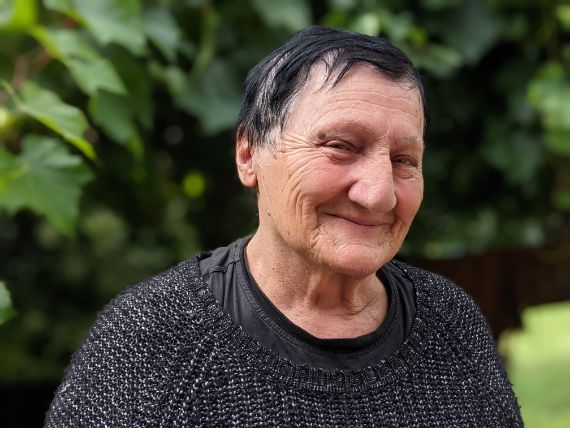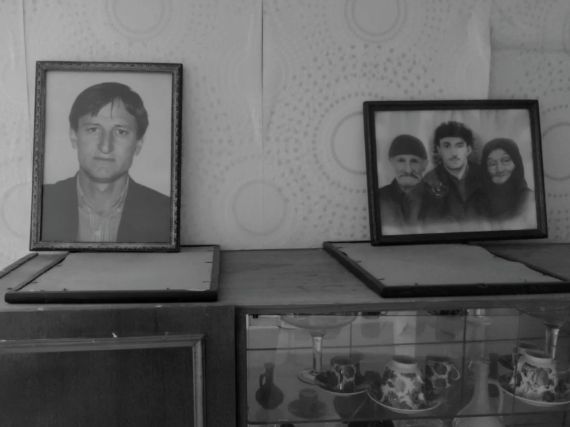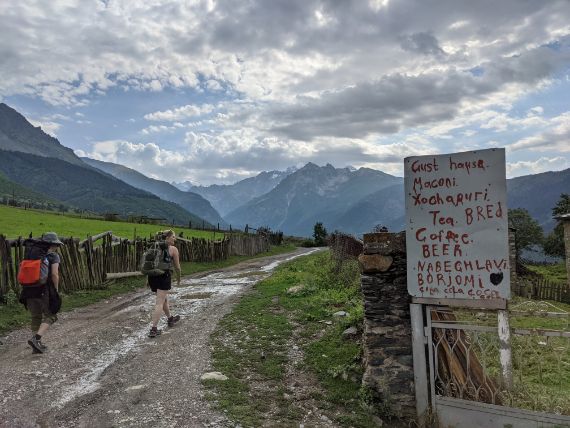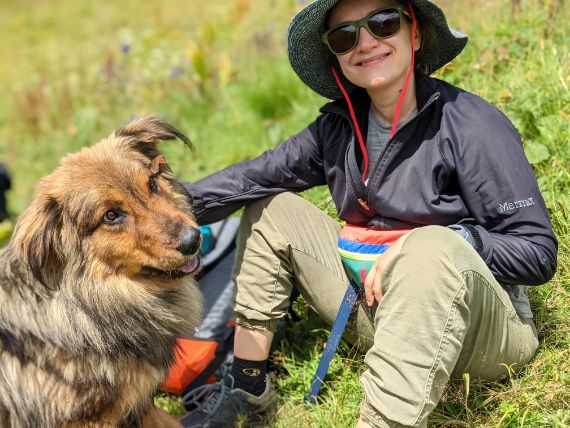IN A STRANGE TOWN.

Chapter 5. October 10, 2021. Text by Kevin. # Comments
Countless dark valleys are reached from passes hidden like the serrated edge of a butter knife. Glaciers rise three thousand feet from their base. Torrential rivers charge out of these ice fields. Every valley has its own language, and where every man was, according to Strabo, “superior to all tribes in strength and courage”. The Russian Tsar spent three decades trying to conquer this tiny part of his empire in the late nineteenth century, joining the Persians, Greeks, Mongols, and Tatars in learning just how hard it is to get an army through each valley, and to keep everyone pacified once your back is turned.
Here you find the Bats and the Kist, the Ghalghai and the Laz, the Migrelians and the Nakh. Abkhazia and South Ossetia and Artsakh have fought their way to quasi-independence in recent years, while Chechnya, Ajaria, and Dagestan have tried. In the 1990s, after the fall of the Soviet Union led old grievances and new opportunism to arise, many of these regions were no-go zones. Yet in this turbulent region, nowhere was as notorious for its isolation, its hostility, and its banditry as Upper Svaneti, home of the wild Svans.
In 2004, the Georgian government sent in the army to try to at last quiet the people. There was a plan, admittedly somewhat crazy. Change this beautiful and rugged land with its proud yet tough residents into a new ecotourism hotspot. Instead of gunpoint robbery, jars of honey and jam for breakfast after leaving the upstairs bunkbeds.
Incredibly, this plan may be working.
A HARROWING FLIGHT


Svaneti is, however, quite a bit more remote. The first option to get there is twelve bumpy hours on a marshrutka slurring into one-house valleys, rockfall littering the path, roads crooked as a post-Soviet apparatchik. Second is a thrice-weekly flight on a tiny airline called Vanilla Sky. This flight takes off not from a tiny tarmac twenty miles out of town with a shack of a terminal, two women checking names off a list, and a salty dog pilot flying under VFR - visual flight rules. What this means is that the plane only goes when the weather is clear and sunny. The mountain passes rarely meet this description.
Our Russian turboprop finally had permission to take off around noon, in a flight not for the fainthearted. The Ossetian, and Lower Svaneti, and Upper Svaneti valleys we would traverse are very narrow, requiring the pilot to slalom his plane through them until hitting a pass low enough to hairpin through. On the right we saw the titans of the Caucasus in the distance: not just Elbrus, but Tetnuldi and Shkara and Janga. On the left, the plane was often so close to the hills that you could count the goats. Each pass we flew over gave the plane a firm handshake - I kept my eyes closed for most of the approach. At last we turned toward Mestia, the “big city” of Svaneti and home to its only airport. More importantly, Mestia was the starting point of a four-day hike through tiny villages and over passes rising to 9,000 feet, ending at the World Heritage Site of Ushguli. We grabbed our backpacks out of the hold, picked up a few provisions, and headed out of town on a steep path as a light drizzle began to fall.
THE TOWERS AND THE THUNDER
The villages of Svaneti, most of which hold only a few dozen residents today, are most famous for their striking defensive architecture. Complexes of towers rising out of low-slung villages are not uncommon worldwide - San Gimignano in Tuscany most famously, but also the temples of Southwest China or the pointed Vainakh towers of Ingushetia - but nowhere are they as widespread or as beautiful as in Svaneti. Typically connected to houses, even small villages may have a dozen stone pinnacles each rising as high as an eight-story condominium. The only entrance is via a small door reached via ladder.
When the valley was invaded, these towers could communicate with each other via semaphore about any danger. The legend goes that solitary towers stood at the bottom of every pass into the valley, each tower able to view one more. If an army invaded, residents would escape to their towers where food and water was always stored, pull up the ladder, seal the entrance, and fire arrows or guns through the embrasures at the crenellated top of each tiny fort. Some of these towers are over one thousand years old, slowly wilting as the villages depopulated.
The three of us plodded uphill as afternoon clouds turned to early evening rain. The track became muddier and the bookends of the valley turned to fog. With the weather only getting worse, we hailed a young boy at the entrance of a small village called Zhamushi, asking if there was anywhere in town to stay. He conferred with his family, who had three suspicious Mercedes in a yard better fit for wandering chickens. They brought us to a four-room house next door. An elderly Svan was melting into her sofa, watching Turkish soap operas. Her middle-aged daughter greeted us in Russian while heating tea on a wood-fired stove. The old woman gave a gum-filled smile as we gave her the traditional Svan greeting, hocha ladegh.
Their two small upstairs beds were available if we wanted them. The curved stairway was partially outdoors and required a limbo maneuver to ascend. Out the window, a dusk sky filled with thunder. Dinner was vegetable soup, Georgian bread, and a salt lick of a country cheese called sulguni. We were in bed by nine and felt like we were at the end of the world.


At lunchtime the next day, we found ourselves at the bottom of a glacier in the pinprick village of Zhabeshi. The side of a fence advertised a guesthouse called Victor’s. A woman hailed us with a smile as bright as the glacier’s snow. She sat us down and began covering the table with dishes: an incredible khachapuri with the dough crispy like lasagna, a basket of fresh fruit, eggplant salad with a tart mayonnaise sauce, bread with fresh honey and berry jam.
The owner’s daughter inexplicably spoke absolutely perfect English, and helped explain the dishes. We asked how, in the most distant corner of Europe’s far periphery, she spoke like a teenager from California. Her answer: TikTok. Naturally. At mid-day, Zhabeshi was quiet, with as many farm animals on the paths as people. We digested contentedly, steeling ourselves to climb over the Ugviri pass to the hidden hamlet of Adishi that afternoon. Did the daughter like living in such a pastoral paradise? She said she thought life would be more exciting in the United States. Fair enough. She did confess that her mother, the chef, also couldn’t wait to leave Svaneti as a teen and now can’t imagine living anywhere else. The value of fresh air and a walk in the mountains increases with age. As we bid them good-bye, the entire family stood in the yard waving us off like grandparents at the end of a summer vacation. And this is meant to be the toughest valley in all of the Caucasus?
TO THE END OF THE ROAD
Adishi is absolutely hidden from view until you are ten minutes walk from its front door, at the bottom of a river valley. Its towers were the most spectacular yet. Many houses were well-preserved, including some built with traditional stick roofs. Knowledge of their construction is now so limited that only one man still knows how to repair them.At our guesthouse, we met a journalist from the capital who spends the summers in the mountains with her Svan husband. She found her first summer hopelessly parochial. Indeed, she confessed being worried that Svaneti might be too dangerous. Her second was a season of making friends. By her third year, she had a back-slapping relationship with the woman next door, whose cooking was famous throughout the village. What had been a shrouded and foreboding valley turned to a much-anticipated childhood summer camp.
Journalists are always interesting to talk to, moreso if they host the politics talk show in a Byzantine part of the world. Our correspondent offered that her family was the only vaccinated one in the village. Many traditional Georgian Orthodox priests were opposed to vaccination, and rural Georgia is a place where no group is more powerful. In official statistics, Georgia had the world’s highest Covid rate when we were visiting, but there seemed to be little concern among her citizens. When it comes to protection, the traditional defenses were preferred: faith and geographic isolation.


The difficulty of reaching this region, either with an army or a disease, was made clear soon after we left the guesthouse. Three young boys stood with their horses on the edge of a waist-deep river. Its current was far too strong to wade across safely. This presented an opportunity far more lucrative than lemonade stands. The boys offered, for fifteen dollars, to put you in the saddle and kick the reluctant equine in its haunches. Our conveyance would then do its best to cross the river without losing its footing, rocking the passenger back and forth along the way. A German-Spanish couple we met later tried to cross without the horse - the girlfriend’s expression told us clearly that we had made the correct choice in supporting local small business.
Our hike that afternoon was less isolated, crossing a high path at the intersection of serious trekking routes. A group of Eastern Europeans with tall hiking boots splashed by us as we gingerly made our way across a marsh. Another trekking group was stony-faced and single-file as they marched past us like a string of ants down the backside of a mountain. A friendly brown dog in their company decided to join us instead, seeking a more relaxed hiking experience. The approach to the village of Iprari, and afterwards the valley’s end at Ushguli, changed from vertical climbs and descents to an easy hillside stroll above a boiling pot of a river, ruddy with runoff, carrying stones and logs in its wake. The environment was again harsher than the people: Ushguli is now a daytrip destination from Mestia complete with coffeeshops, guesthouses, and guided architecture tours.
It is inevitable that each year, less of the planet is a blank space. Tourism will find the places most worth visiting, and impose at least a degree of sameness upon them. This is a pattern often denigrated: where will we find the real adventure, the sense of discovery, the serendipity? The counterpoint has it better, however. When geographic distance, missing roads, a lack of safety, and simple ignorance keep a place in the shadows, we all have no opportunity to see it as its most hospitable. Tourists allow history and architecture to be preserved, mountain hikes to be cleared. Bandits transform into storytellers, musicians, guesthouse owners, and chefs. The Svans’ reputation is now one of kind-hearted host rather than wild brigand, a change wonderful both for them and for the world.
Text by Kevin
Mestia, Georgia
October 10, 2021
Tweet
Practical Details - Georgia
Hotels
In Tbilisi, the Rooms is an international-quality boutique hotel with Marshall hi-fis in each room and a lovely cocktail list [$200]. The group runs two other hotels in rural Georgia, though none in Svaneti.
Mestia has many options, all fairly nondistinct, from [$30-$80]. None are particularly intruiging. On the hike to Ushguli, Victor's in Zhabeshi is the obvious choice. In Adishi, Gunter's is a traditional stick-roofed building with a great breakfast. In Iprari, we stayed at Uche. A room with breakfast everywhere is roughly the same price [$20-$30 per person], some of which can be booked online. ATMs are available nowhere after Mestia.
Puli Mini [doubles from $82] is an impossibly cute, full-board, traditional house in the mountain valley of Camlihemsin just over the Turkish border, with very friendly owners.
Food
In Svaneti, the only restaurants between Mestia and Ushguli are guesthouses; as mentioned, Victor's Guest House is a must. A particularly herbal version of khachapuri can be found throughout Svaneti.
Transport
We left Georgia via Batumi to Northeastern Turkey - Mestia to Batumi in a private car via GoTrip.ge [$110], then a short taxi to the border and a bus to Camlihemsin. The flight to Mestia on Vanilla Sky is bookable online [$30].